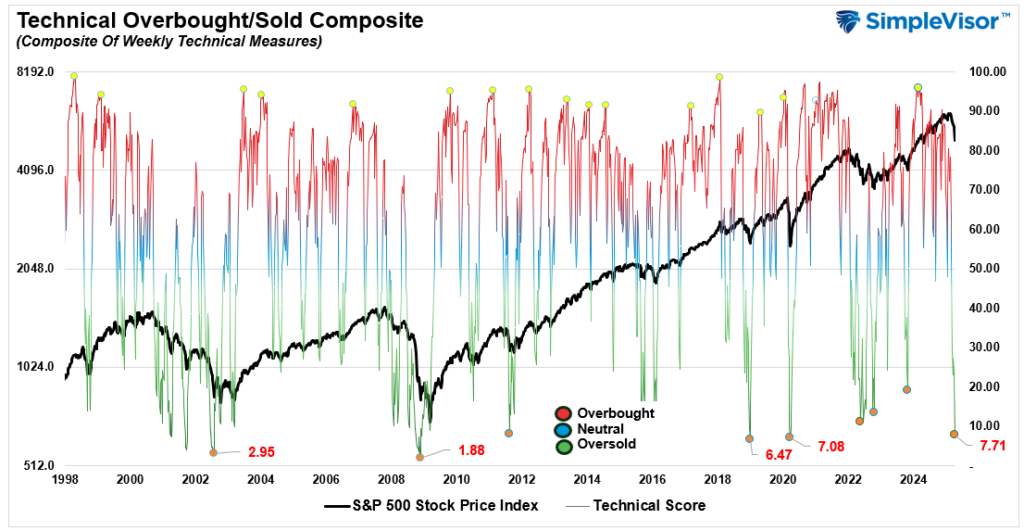UnitedHealth tests AI system to streamline medical claims processing - Bloomberg
“Resistance is futile” was a sentence that struck fear in the hearts of Trekkie fans during “Star Trek: The Next (LON:NXT) Generation,” specifically in both of the “Best Of Worlds” and “First Contact” episodes. In those episodes, the “Starship Enterprise” crew encountered a species called the “Borg.” The Borg’s primary purpose was to achieve “perfection” by assimilating other beings and technologies into their “hive mind,” known as the “Collective.”
They viewed assimilation as a means to expand their collective knowledge, power, and ultimately, their vision of a perfect and harmonious existence. The reason “resistance was futile” was that the centralized control, driven by the Borg Queen, allowed for swift and coordinated actions across vast distances. At the same time, the assimilation process threatened to erase individuality and homogenize the galaxy.
I could go on, but you are asking yourself two questions. First, is Lance a total sci-fi geek? Second, what does this have to do with the markets and investing? The answer to the first question is “yes,” as I grew up with William Shatner as James T. Kirk in the original Gene Roddenberry “Star Trek.”
However, let’s dig deeper into the second question.
Over the past two weeks, the market has had a furious nine-day rally, the longest winning streak in 21 years. However, there are two takeaways from such a historic advance. First, it is “bullish” as investors return to the market. However, investors should also recognize that if the rally is the longest in 21 years, then previous such rallies failed.
As shown in the chart below, there have been longer rallies, with 14 trading days being the peak. But in every case, it is worth remembering the following:
“‘Record levels’ of anything are records for a reason. It is where the point was reached where previous limits existed. Therefore, when a ‘record level’ is reached, it is NOT THE BEGINNING, but rather an indication of the MATURITY of a cycle.”
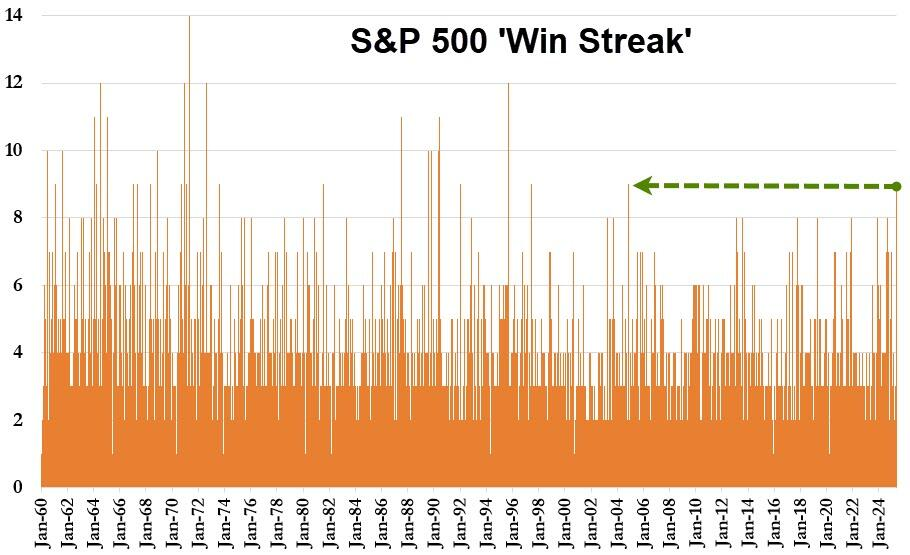
That reality exists for any data set, at either extreme. Let’s look at two examples.
The Bearish Example
On April 7th, the day the market bottomed, I wrote an article entitled “Hope In The Fear,” in which we discussed the extremes of “bearish sentiment” and technically oversold conditions. To wit:
“There are times when the probabilities of something happening outweigh the possibilities. Following last week’s market crash, the “probability” of at least a near-term rally outweighs the possibility of a further decline. Does that mean it is guaranteed to happen? No. But, several indicators have historically tilted the odds in the investor’s favor.”
The reason was the extreme technical oversold conditions that existed.
“Whether or not the current market crash is the beginning of a larger corrective cycle, such low readings have, without fail, marked the near-term low of a market correction. While the market has previously continued its corrective process after such low readings, such did not occur without a meaningful reversal rally first.”
When analyzing the market from a technical perspective, technicians watch two primary levels: support and resistance. As always, the demand between buyers and sellers determines stock prices. When the supply of stock for sale overwhelms the demand from buyers, “resistance” occurs, which impedes prices from moving higher.
The same happens during declining markets, where resistance (support) to lower prices forms as the demand from buyers overwhelms the supply of stock for sale.
In that April 7th article, we stated that the markets were three standard deviations below long-term moving averages and challenging rising trend lines. In other words, those were previous levels where “resistance was futile,“ such oversold conditions typically precede short-term rallies to allow investors to reduce exposure to equities. We also noted that the target for a tradable rally was between 5500 and 5700. (The market closed at 5686 on Friday.) 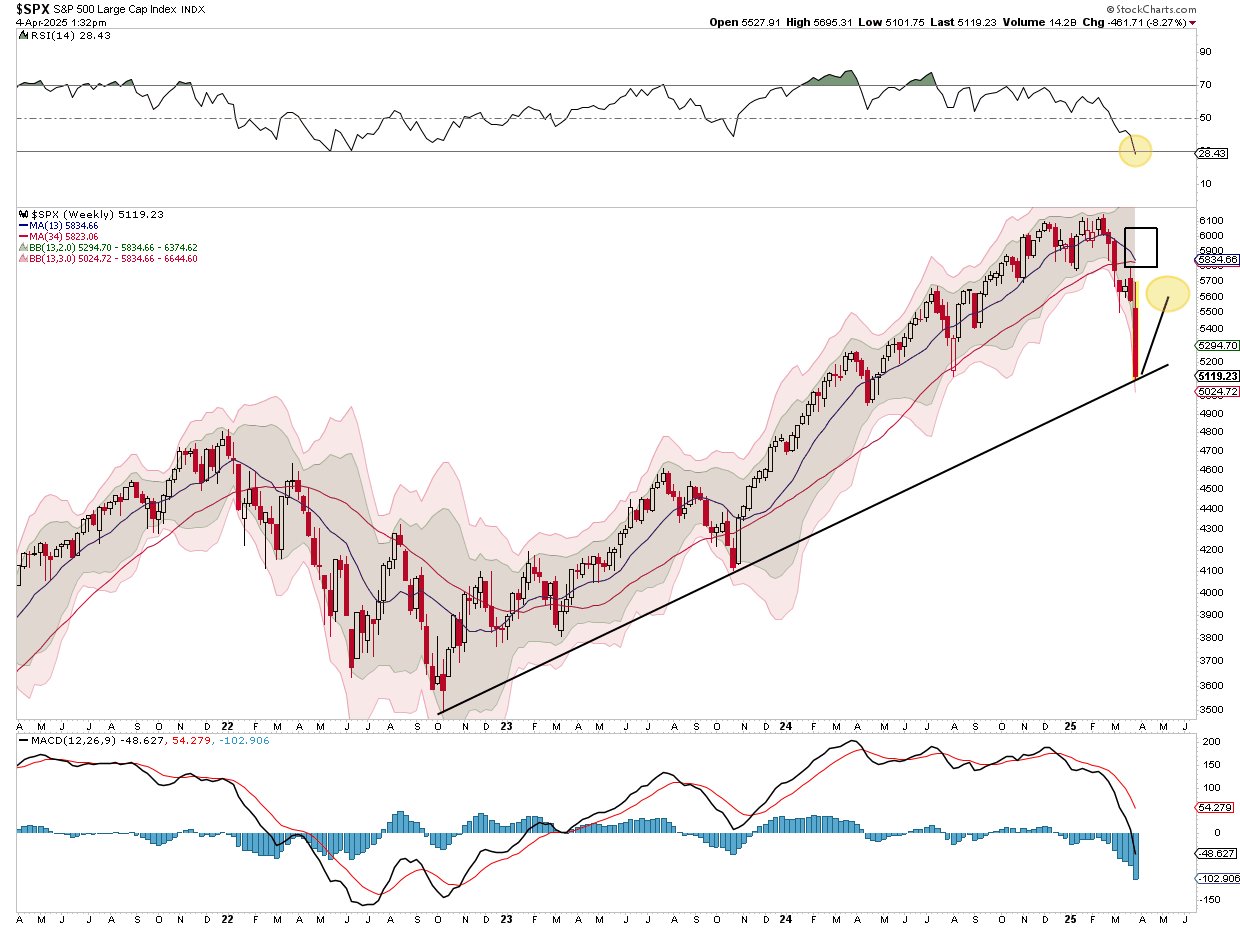
Such is why we focus heavily on investor sentiment and positioning. When investors are extremely bearish and are “panic liquidating” equity exposure during a market decline, that is often a contrarian indicator that resistance to a further decline is forming. When sellers become exhausted, it only takes a few buyers to push higher prices. Of course, when resistance to lower prices forms, the media headlines are often the most negative, and investors’ “loss aversion” behavior is the most extreme.
As we concluded in that article:
“It won’t take much for the market to find a reason to rally. That could happen as soon as next week. If the market rallies, we suggest reverting to the basic principles to navigate what we suspect will be more volatile this year. However, at some point, just as we saw in 2022, the market will bottom. Like then, you won’t want to believe the market is bottoming; your fear of buying will be overwhelming, but that will be the point you must step in.
Buying near market lows is incredibly difficult. While we likely aren’t there yet, we will be there sooner than you imagine. As such, when you want to ‘sell everything,’ ask yourself if this is the point where you should ‘buy’ instead.“
But what about the bull case?
Resistance For The Bulls
As with the bears, “resistance is futile” for the bulls just as much. As noted above, the market has had the longest “positive day” stretch in 21 years. While the media is becoming more convinced that the “bulls are back in town,” which is probably true, it should also be a warning that “resistance” to higher prices is forming since such previous winning streaks have failed.
As noted above, the relentless market rally has pulled many investors back into the market over the last few weeks. Sentiment has quickly changed from extremely bearish to bullish, and professional investors have rapidly ramped up exposures. While sentiment and positioning are not yet back to extremes, the market has technically reversed much of its previous oversold and technically deviated conditions.
Most notably, the market is now approaching the 200-DMA, which is a level at which many buyers were stepping in before the “Liberation Day” market plunge. Many buyers are close to getting back to even and will likely be inclined to sell as they approach breakeven. Furthermore, the 100-DMA, which is close to crossing the 200-DMA, provides further resistance. As noted in “Death Cross,” these moving average crossovers impede further price advances until they reverse.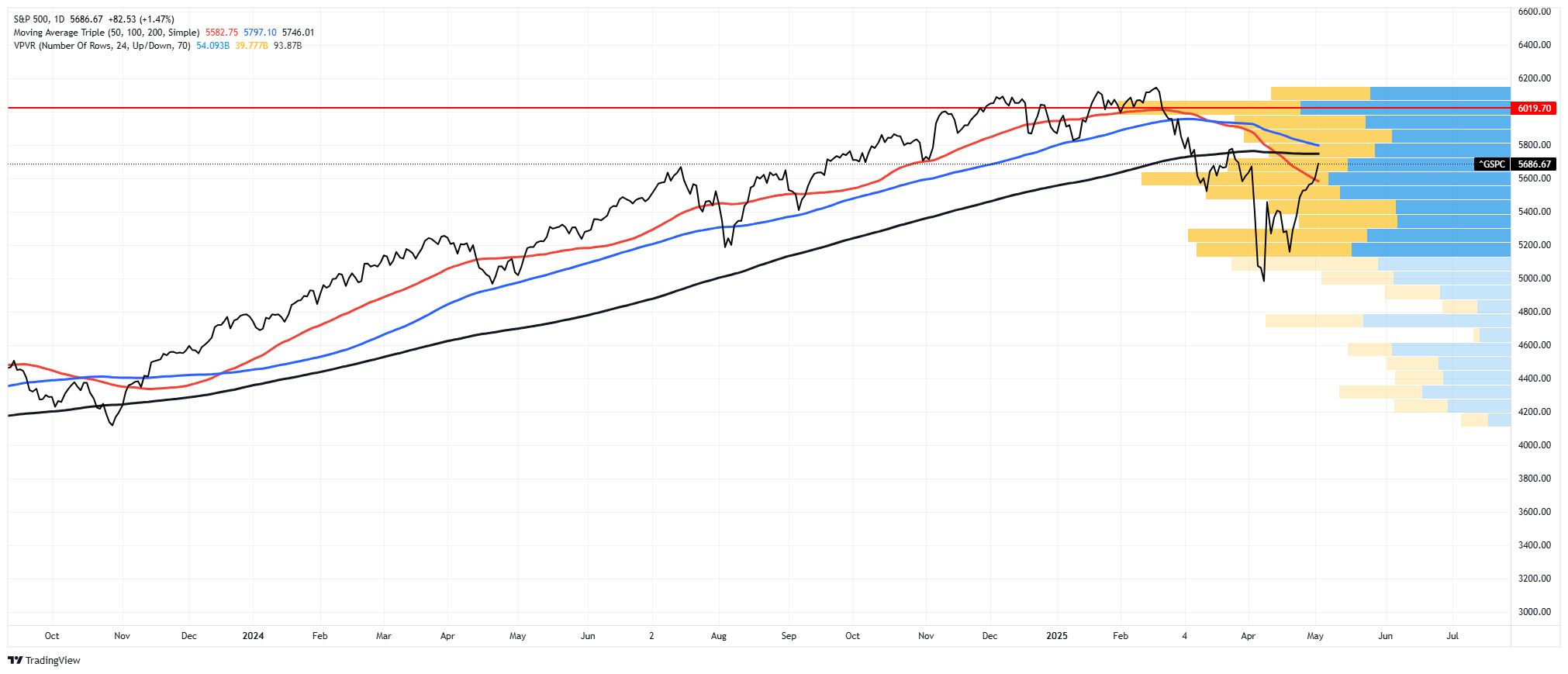
The 100 and 200-DMA moving averages have historically defined market trends. For example, the 100-DMA (blue line) supported market pullbacks during 2021 and since the October 2022 lows. Conversely, those moving averages defined the peaks of reflexive rallies during the 2022 correction. With the markets again trading below those averages, seeing sellers emerge as markets approach those resistance levels would be unsurprising.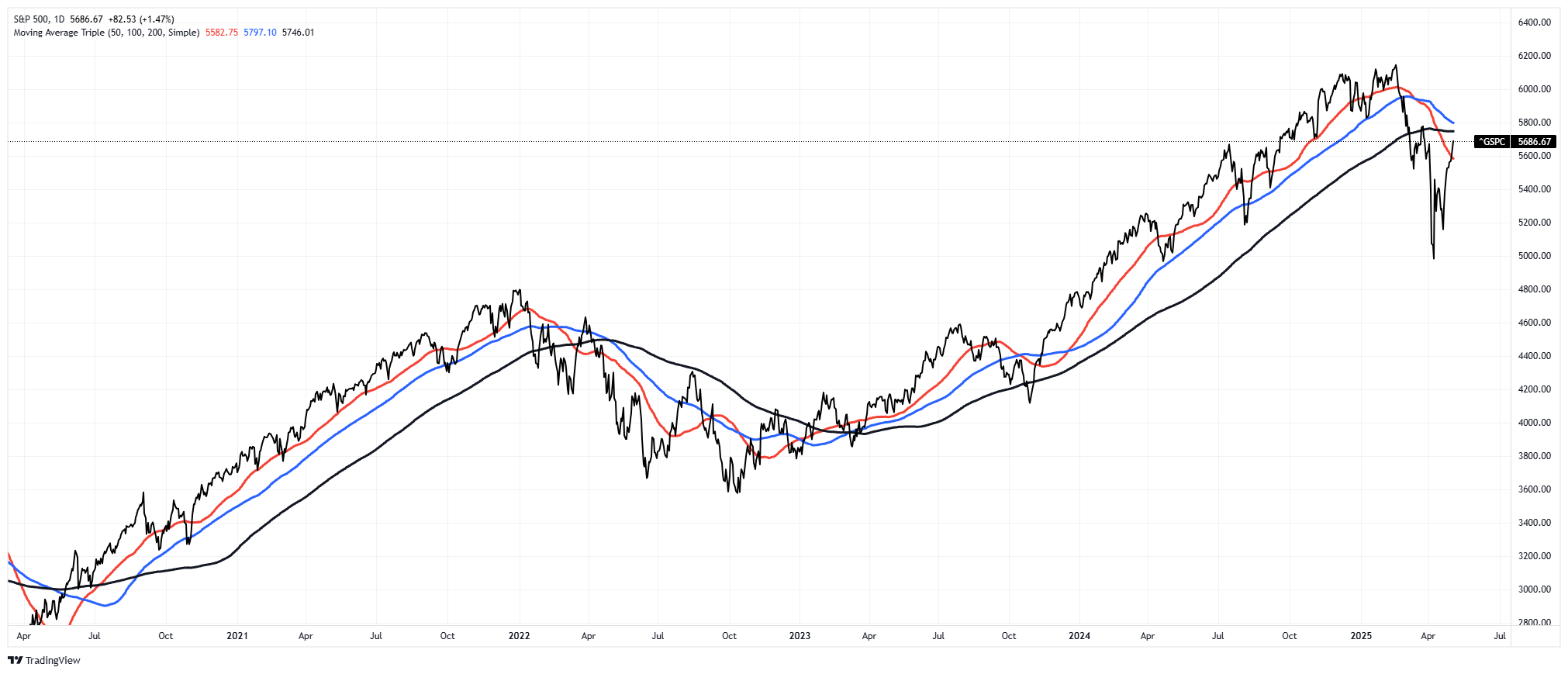
Is the current correction over, and is the bull market resuming? Maybe. We certainly saw such a situation in the summer of 2023, when the markets declined 10%, a “death cross” occurred, and markets immediately bottomed and surged to new highs. Then, like today, there was a surge in corporate buybacks and a quick reversal of very bearish sentiment.
However, as shown in the chart above, even if we are experiencing a 2023-type scenario, there will be short-term corrections and pullbacks, providing investors an entry point to increase equity exposure as needed.
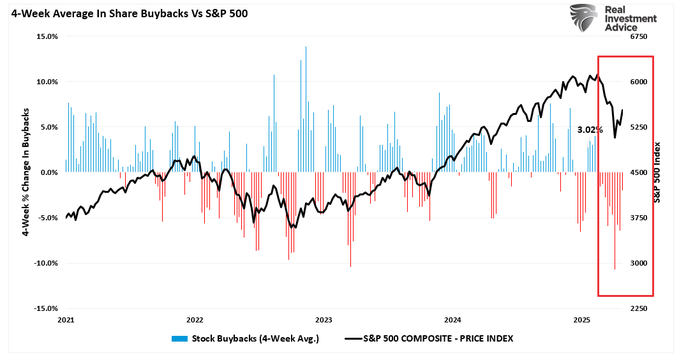
So, how do we know if the current market is like 2022 or 2023? Should investors be selling rallies or buying dips?
Beating The Borg
In Star Trek, the crew of the Enterprise eventually defeats the Borg through a combination of strategic attacks and exploiting weaknesses in their collective structure. The crew of the USS Enterprise-D, led by Captain Picard, used their access to the Borg collective, through Picard’s assimilation, to their advantage and were able to disable and destroy the Borg cube by exploiting its regeneration subroutines. Unfortunately, defeating the “collective” of our emotional biases when investing isn’t much easier, but it is possible.
Interestingly, when I write posts like these, someone often comments, “Why won’t you just tell us whether the market is going up or down?” It’s a fair statement, but unfortunately, I am not prescient, nor is anyone else, and navigating markets does not work like that.
If I want to be bearish, it is easy to state the market is at resistance and about to crash, so you better “get out now.” Or, if I wanted to be bullish, I could point to October 2022 and make the case why markets are about to surge higher. Either prediction has a decent chance of being wrong, leaving investors on the wrong side of the trade. As such, this is why we don’t predict, but instead navigate the current market for the possibilities versus the probabilities.
Historically speaking, when markets break longer-term moving averages, the first attempt at reversal often fails. Notice that I said “often” and not “always.” That is because sometimes markets do the unexpected, and, as investors, we must be able to recognize the change and respond accordingly. Such is why we never recommend entirely getting out of markets.
In a recent #BullBearReport entitled Spock & The Logic-Based Approach To Investing, we discussed that as investors, we must weigh possibilities and probabilities and manage our risk accordingly. To wit:
“Investing means cutting through noise, avoiding speculation, and relying on data. For example, the media is jammed with emotionally charged headlines about tariff-induced trade wars, recessions, and de-dollarization. In reality, those events rarely occur. The chart below shows a normally distributed bell curve of potential events and outcomes. In simple terms, 68.26% of the time, typical outcomes occur. Economically speaking, such would be a normal recession or the avoidance of a recession. 95.44% of the time, we are most likely dealing with a range of outcomes between a reasonably deep recession and standard economic growth rates. However, there is a 2.14% chance that we could see another economic crisis like the 2008 Financial Crisis. But what about “economic armageddon?” That event where nothing matters but ‘gold, beanie weenies, and bunker.’ That is a 0.14% possibility.“
So, Where Are We Now
If you want my best guess, here it is:
- We’ve likely seen the market lows for this year.
- We’ve likely seen the highs as well.
Navigating a market trapped between support and resistance becomes emotionally challenging. Investors face sharp rallies into resistance — and retracements back to support — wearing down sentiment until mistakes happen.
Therefore, this is how we are positioned in this current and uncertain market environment.
- Primarily long equities, as the market structure remains bullish.
- Increased cash levels to manage policy and growth uncertainty.
- Short S&P 500 index to hedge downside risk.
We also recommend a healthy portfolio and risk management regimen.
- Tighten up stop-loss levels to current support levels for each position.
- Hedge portfolios against more significant market declines.
- Take profits in positions that have been big winners.
- Sell laggards and losers.
- Raise cash and rebalance portfolios to target weightings.
Here’s the hard truth: you can’t measure risk in advance.
Markets are unpredictable, and while we can guess what might happen, the future is uncertain. When we think about risk, most of us focus on the risk of losing money. However, there are other risks we should be aware of, like missing out on gains by playing it too safe or being forced to sell investments during a market crash. Both can be just as damaging to our portfolios in the long run. We don’t have any foresight into what the market will do next week or month.
All we can do is remain focused on our portfolio, manage the risk of “being wrong,” and realize that “resistance is futile” when investing in the market. As Howard Marks once penned:
“Too little skepticism and too much eagerness in an up-market – just like too much resistance and pessimism in a down-market – can be very bad for investment results.“
Just something to think about.
Now, “Make it so.”

